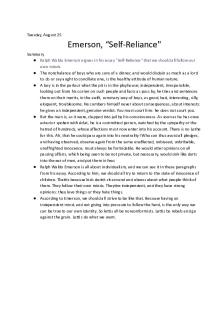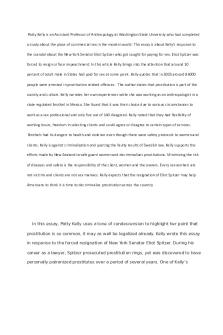Silent Spring Rhetorical Analysis - Self Reliance PDF

| Title | Silent Spring Rhetorical Analysis - Self Reliance |
|---|---|
| Course | StuDocu Summary Library EN |
| Institution | StuDocu University |
| Pages | 3 |
| File Size | 77.2 KB |
| File Type | |
| Total Downloads | 10 |
| Total Views | 135 |
Summary
Summary...
Description
Rachel Carson’s Silent Spring Rhetorical Analysis Growing up in Montana, I have been privileged to experience beautiful scenery. From towering mountains, to flowing creeks, to grassy fields, the landscape never ceases to amaze me. I want generations after me to be able to enjoy and experience Montana for all that it is. To think of the landscape and animals destroyed by humans or humans and their chemicals makes me sick. In her book Silent Spring Rachel Carson analyzes and criticizes our use of pesticides in the environment. It is our incessant determination to rid the world of insects that results in the ignorant destruction of hundreds of other species as well, including ourselves. Carson critiques the use of poisonous chemicals to eradicate insect pests, arguing that the consequences of our actions are not thoroughly considered. Carson begins (lines 1-32) with a scene of animals meeting their unavoidable death by careless humans and their parathion in a gruesome and warlike atmosphere. In this section, she focuses on birds becoming more of a “direct target” than an “incidental one,”a problem that could have easily been solved if farmers had cared enough to simply change part or parts of their agricultural practice. Her tone is accusatory and often sarcastic, as she condemns the eradication of any species that may “annoy or inconvenience us.” She is clearly arguing a specific group is to blame for this awful murder in cold blood. Carson describes this process as a “habit of killing,” implying we no longer think about what is being done. She uses a specific number to enhance her ethos— “65,000 blackbirds” — which she describes as a “casualty list,” implying that the farmers were somehow keeping track of how many animals they could kill. These elements allude to a warlike atmosphere which she furthers by explaining that those with poisons sent in planes on a “mission of death,” their only goal being to annihilate everything in their path. We are waging an unstoppable war on innocent creatures and the impacts are outrageous; whole species could go extinct from our carelessness and our lack of understanding. Carson also plays to the reader’s pathos by describing the rabbits, raccoons, and opossums who had “roamed these bottomlands” but never set foot on the farmers’ fields, doomed to become victims as well. She calls the parathion a “universal killer,” signifying there must be a way to be discriminatory when the poison is
used; there is no need to ignorantly kill everything. She depicts the users of the poison as the “judge and jury,” using the metaphor to convey that the animals never receive an actual and fair trial because farmers didn’t care to learn of their existence. She blatantly accuses them of acting outside their boundaries. We aren’t expected to consult animals but we are expected to understand the implications of our actions. Next, Carson furthers her argument (lines 33-46) by targeting humans and the life threatening impact the poisons have on them. Carson denounces our incessant disregard for our surroundings, what might be living there, and how our actions affect the delicate balance of the ecosystem. Humans are not left out of the terrible effects though; workers needed medical attention a “month” after being exposed to the chemical; the amount of time the poison was left to absorb into the foliage didn’t change any effects. And while humans can receive medical attention, birds certainly cannot. Carson knows we are not only destroying animals’ lives but also our own. Our “misguided search for unspoiled nature” is a waste of time because nature untouched or unharmed by human hand doesn’t seem to exist. Her tone in this section switches to a harsh, biting one as she poses rhetorical questions such as if Indiana still raises boys who “roam through woods or fields” wondering if they “might even” be allowed to explore anymore. These boys have had the adventure taken away from them because of the parathion. Carson also returns to the war metaphor by describing the poison as a “lethal film.” By paralleling that with “innocent” she is suggesting a naive attitude to a serious problem. War is not something that should ever be taken lightly and we cannot ignore the seemingly violent acts we are committing on nature and ourselves. Her main concern is our lack of interest in an increasingly troubling issue; with no desire to change, she wonders what it will take for us to see the incredulous events happening. Finally, Rachel Carson ends her argument (lines 47-65) by calling us to action and to fully acknowledge the motives behind the use of parathions. In this paragraph, Carson makes makes clear that humans and animals are threatened by a common deadly force, especially if we continue on the path of destruction. Carson describes this “ever widening wave of death” like a “ripple in a pond” emphasizing the effect the parathion is having on everything we know. We spiraling down a path we cannot control; the chain of events has already been started and the consequences will only get worse. She articulates how
simple it should be for us to decide between leaves that “might have been eaten” and the poor helpless birds fallen before an “unselective bludgeon of insecticidal poisons” by using the scales of justice and tying it back to the judge and jury in the first section. The imagery in this metaphor emphasizes that a conscientious decision to kill other animals is being made and that justice is not being represented at all. Rachel Carson is calling us to action because we should all have the “right to decide” when it comes the decisions made that terrorize our surroundings. By repeating the word “who,” she uses anaphora to emphasize the mystery behind the authoritarian making these decisions when in reality “countless legions” should care enough to help decide. Since the use of this poison is effecting not only us but animals too, we should all feel called to change our practices. There are ways to use the poison’s without destroying all that is around us and it is our responsibility to take care of our surroundings. The world is a beautiful place, and the “inattention” to that beauty is what ultimately compels Rachel Carson to call us to action. Montana will always be my home and to see it destroyed like Rachel Carson describes is devastating. Carson’s message rings clear: we need to figure out the problem and fix it. She knows what is happening is wrong, she just hopes we can all see it too.!...
Similar Free PDFs

Self Reliance Summary
- 2 Pages

Self reliance debate - Summary
- 9 Pages

Emerson, “Self-Reliance\"
- 1 Pages

Riassunto Silent Spring
- 6 Pages

ULASAN BUKU SILENT SPRING
- 11 Pages

Rhetorical Analysis
- 5 Pages

Rhetorical analysis
- 2 Pages

Puppy Rhetorical Analysis
- 4 Pages

Rhetorical analysis -1
- 4 Pages

Bowling Dana Rhetorical Analysis
- 4 Pages
Popular Institutions
- Tinajero National High School - Annex
- Politeknik Caltex Riau
- Yokohama City University
- SGT University
- University of Al-Qadisiyah
- Divine Word College of Vigan
- Techniek College Rotterdam
- Universidade de Santiago
- Universiti Teknologi MARA Cawangan Johor Kampus Pasir Gudang
- Poltekkes Kemenkes Yogyakarta
- Baguio City National High School
- Colegio san marcos
- preparatoria uno
- Centro de Bachillerato Tecnológico Industrial y de Servicios No. 107
- Dalian Maritime University
- Quang Trung Secondary School
- Colegio Tecnológico en Informática
- Corporación Regional de Educación Superior
- Grupo CEDVA
- Dar Al Uloom University
- Centro de Estudios Preuniversitarios de la Universidad Nacional de Ingeniería
- 上智大学
- Aakash International School, Nuna Majara
- San Felipe Neri Catholic School
- Kang Chiao International School - New Taipei City
- Misamis Occidental National High School
- Institución Educativa Escuela Normal Juan Ladrilleros
- Kolehiyo ng Pantukan
- Batanes State College
- Instituto Continental
- Sekolah Menengah Kejuruan Kesehatan Kaltara (Tarakan)
- Colegio de La Inmaculada Concepcion - Cebu





